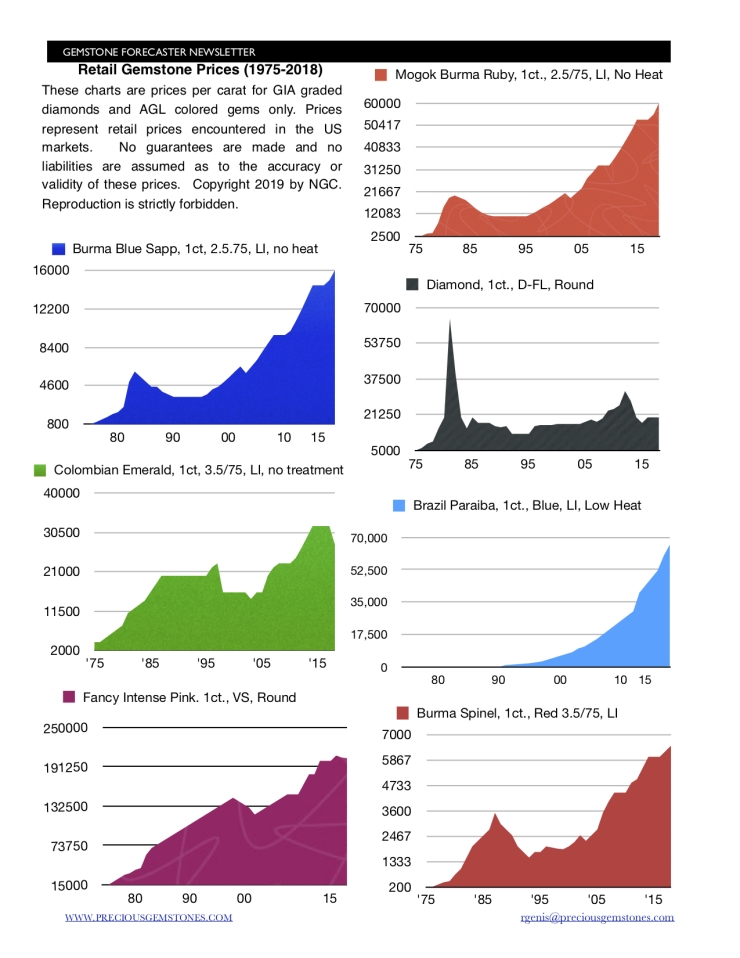VOL. 37, #1, Spring 2019
Perspectives on the Tucson Gem Show?, Latest Gemstone News, Gemstone Trends (1975-2018)
- Home
- Newsletter
- VOL. 37, #1, Spring 2019
Perspectives on the Tucson Gem Show?, Latest Gemstone News, Gemstone Trends (1975-2018)
Perspectives on the Tucson Gem Show
by Robert Genis
This was the 65th anniversary of the Tucson Gem Shows. What started in an elementary school in 1955, now brings $120 million into the city. Approximately 60,000 visitors come to see 48 shows. The shows are almost too large to handle anymore. We are worried these new dealers are selling misrepresented gems and doctored crystals/minerals. This is documented on social media sites. These shows can be dangerous to your wallet. Caveat Emptor.
Here are our takeaways-
Show Results
It seems like most dealers had either a really good show or a really bad show. So dealers I spoke to were either enthusiastic or totally depressed. It was difficult to determine the cause of this because it didn't appear to be the type of goods the dealers had.
Some speculated if you used social media in advance, you probably had a better chance of selling a greater amount of goods. We don't think that explains it, as one of our best colleagues had a great show and wouldn't know how to post to facebook, instagram, or snapchat if his life depended on it. Traffic started strong and declined thereafter. Seems like everyone wants to be at these shows the first day they open. After they buy what they want, they tend to spend the rest of the week enjoying the Tucson weather. Except this year it snowed and rained almost every day!
Ruby
Large quantities of ruby were seen throughout the show. Naturally, most of the stones were Madagascar rather than Burma. The Madagascar dealers try to sell these goods as the "New Burma for less money." Interesting pitch but doesn't sit well with the old school dealers and Burma aficionados. Of course, I was searching for true gem pigeon blood rubies (2.5 color AGL) for my clients. What is hilarious but almost sad is all the rubies have grading reports from junk labs.
They say any stone that is remotely red is pigeon blood color. I can tell you we only saw about 10 stones in the entire show I would properly classify as pigeon blood. The other 99.9% were not pigeon blood at all. If you don't know what you are doing and you believe these certs, you can get really hurt financially.
Of course, prices remain high for the unheated Mogok material. The only gem vivid blood red Mogok three carat rubies were $100,000 per carat. The dealers that own these stones are market makers.
They are in no hurry to sell. Either they are ahead of the price lists or are speculating these goods are so rare, prices have no where to go but up. We remain bullish.
Sapphires
We spent a great deal of time looking for unheated Burma sapphires and Kashmirs. We only saw about 6 Kashmirs at the show. Just because a stone is Kashmir doesn't make it a top stone. Let me correct this statement. Just because a stone has a grading report stating it's Kashmir, doesn't make the stone desirable. As most of my collectors know, Kashmirs often are too dark in tone and black out. Also, many other certed Kashmirs are too light in color and look more like Ceylon sapphires than rich Kashmirs.
Again, you cannot count on many of these lab reports to buy a stone. You need to see these stones with your own eyes to make a proper decision. The one gem Kashmir we saw was over $50,000 per carat, It was a three carat perfect stone (pictured below). We were surprised to see most top gem three carat unheated Burma sapphires were in the $10,000-$15,000 per carat range.
The relatively new trends in Burma sapphire are the light blue, teal and green colors. These pastel colors are a hot market. This is a classic example how gem markets can change. Once rejected in the world market, they are now desirable colors. These carat sized stones wholesale for around $1000 per carat and more for larger sizes.
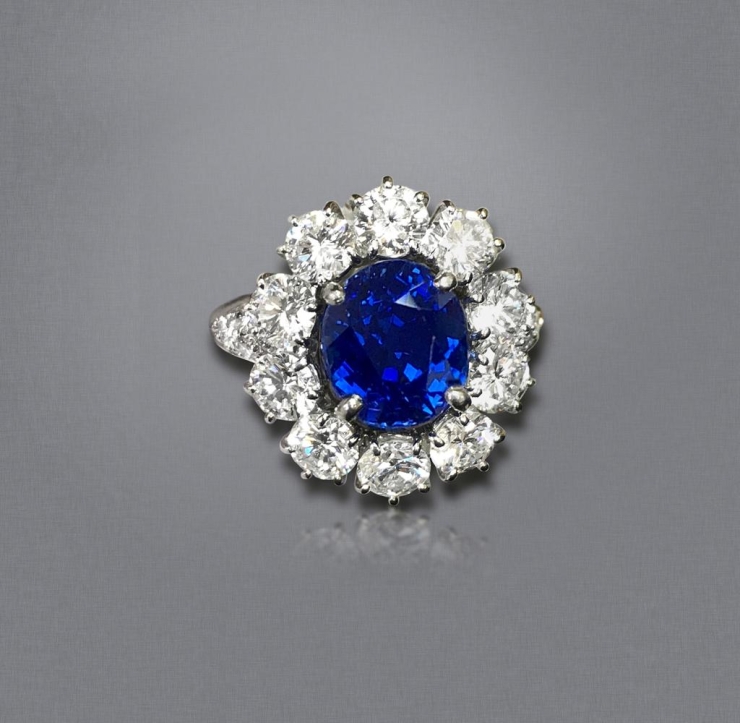
Padparadscha Sapphire
We scoured the show for Sri Lankan or Madagascar pads. You see a great deal of these stones with funny grading reports. I have to say the vast majority of these stones didn't look like Pads. I contend Pads are an ideal combination of pink and orange or orange and pink with light tones. Many of these stones have a darker tone and some brownish color. Dealers are really pushing the limit of how to define these stones. Why not? They surely can sell these stones for a great deal more money if they receive the coveted Padparadscha classification. Prices for true Pads are rising.
Emerald
The newest member of the emerald world is the relatively new Ethiopian emerald. Very little was evident and it appears the first strike has played out. It will probably take the major players in Ethiopia to invest more money into machinery and engineering to find more of the material.
Meanwhile in Colombia, Fura, a Dubai company listed on the Canadian Stock Exchange, is presently mining by taking over the Coscuez mine. It has not produced for the past 20 years. They initially invested $10 million.
Due to the treatment issues that plague this gemstone, prices are weak and declining. Even though collectors only want untreated emeralds, we believe the prices of even these goods may also be affected.
Hot Stones
We did see a small amount of Grandidierite this year from Africa As a general rule, these stones are cabachons or are not very pretty. The gems at the show are fully transparent faceted gems.
As collectors know, these one of the rarest gems in the world. They are a pretty bluish green color. I'm keeping my eye on these.
Paraiba Tourmaline
Of any colored gemstone, the Brazilian Paraiba prices relentlessly move upward. It appears to me there was a lot less material this year, even with the goods from Africa. Brazilian Paraiba has surpassed Kashmir sapphire in price.
Pariaba is now about the same as unheated Burma ruby. Will it surpass ruby to become the most expensive colored stone?
Blue Spinel
Although we tend to follow red, pink and orange spinels, we saw the most outrageous blue spinel at the show. It was the exact color of a tip top Kashmir. The Cobalt blue spinel (pictured below) is 2.76 and you better sit down to hear the price. The asking price was $60,000 per carat! Yes, that is more than a price of a similar Kashmir. You could make an argument the blue spinel is rarer, but gem history has a great deal of influence in pricing. That's why everyone wants Kashmir and Burma sapphires, Burma rubies, and Colombian emeralds. How many people ever ask for a blue spinel?
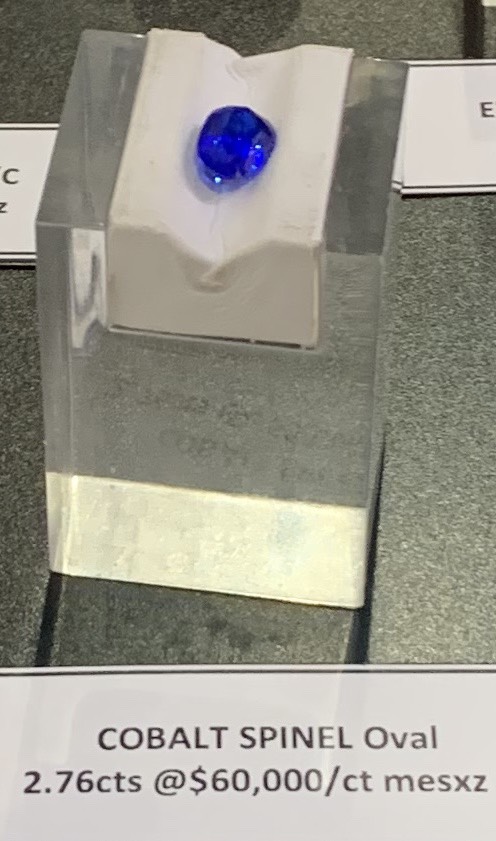
Did China's Wealthy Elite Secretly Move Capital Offshore via Hong Kong's Gemstones?
CCN
by Melanie Kramer
January 27, 2019
Seems pretty obvious what the Chinese are doing with gemstones right now. It's a vehicle to move their currency out of China. So many wealthy Chinese wanting to emigrate is truly Randian. The main source here is one our favorite blogs, ZeroHedge. Sorry if some of the charts are difficult to read due to size. Edited for space. ED
There's attention being drawn to an anomaly in China's trade data. Compared to imports of precious gemstones from Hong Kong, it could point to China's wealthy overpaying for said imports. A method of moving capital out of the country that bypasses China's capital controls.
An Outflow Of Capital?
The first trigger is an increase in China's capital outflow at the end of 2018. It correlates with both a devaluation of the Chinese yuan and an increase in the value of imports from Hong Kong.
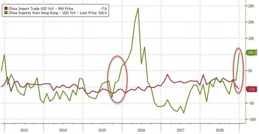
Source: ZeroHedge
As noted by ZeroHedge and reported by the Financial Times, citing RBS strategist Elsa Lignos, there has been a recent rise in imports to China of precious stones from Hong Kong. That rise constitutes 53% of China's total imports from Hong Kong. A figure that was just 2.9% in February 2018.
A Victorious Cake Tweet
FT: "Diamonds, opals, and other precious gems accounted for 53% of China's imports from Hong Kong in November, up from a low of 2.9% last February." -> way to evade capital controls and get money out "
Jeffries analysts note that at the same time there was "slower consumption" in the potentially comparable market of "big ticket gem-set jewelry." This means the hike in imports of precious gems from Hong Kong might not correlate with market behavior.
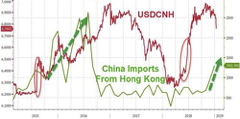
Source: ZeroHedge
As per the Financial Times, if China's wealthy are "using the notoriously opaque gem trade to evade capital controls and transfer assets out of China" then: This may be an ominous sign for the direction of the Chinese currency, and by extension, the economy.
A recent appreciation of the Chinese yuan may have removed the incentive for Chinese citizens to secretly move capital offshore. While the value of the yuan was falling in 2018 capital outflow risks were more of a concern for China.
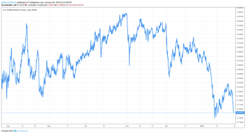
Months Source: TradingView
Analysts are now watching to see if "imports" of precious gems from Hong Kong fall again. If this trend persists, it may potentially shroud capital exiting from China. Then, the yuan may once again devalue.
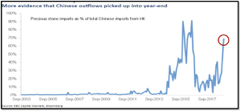
Source: Bloomberg
Otavio (Tavi) Costa Tweet
"More signs of Chinese capital outflows rising again: China's imports of precious stones accounted for 69% of overall imports from Hong Kong last month. Highest % since the mini yuan devaluation in August 2015."
Capital Controls In China
China imposes strict capital controls. Individuals can move no more than the equivalent of $50,000 out of China each year. Chinese companies are only allowed to exchange yuan to the US dollar and other currencies when approved to do so. The Asia Times suggested on January 3 that these exchange controls were being subtly tightened.
ZeroHedge reporting says "unofficially, China's capital controls" have been "skirted" for years. Other reporting suggests that despite potentially increasing efforts to prevent capital outflows not only is that outflow happening but that China's wealthiest are themselves leaving too.
Apparently, a third of Chinese millionaires in a survey say they are considering emigrating. And, that another report found two-thirds of China's wealthy were already emigrating or had plans to leave China.
The Impact Of Capital Outflow In China
Chinese investment into companies in the wider global economy has also slowed as China looks to offset a potentially cooling economy by keeping money closer to home.
To encourage inward investment China has doubled the amount allowed to flow into its equities markets via its foreign institutional investors (QFII) program. Taking the permitted figure to $300 billion. A Commerzbank analyst noted this was also a "genuine gesture" to ease trade talks with the US. In 2015 China saw an outflow of capital that it took until 2017 to slow.
Once that happened and capital outflows turned to inflows China's economic outlook strengthened. A return to greater capital outflows and a falling yuan, combined with falling economic growth would detriment China's economy. Experts are concerned that a slowdown in Europe and China could trigger a global recession.
Take a trip down India's gemological history
Khaleejtimes
by Melissa Randhawa
January 26, 2019
A brief, fascinating history of India and gems. My wife recently returned from a trip to India, and was struck by the amazingly beautiful use of gemstones to adorn palaces, temples, and even the Taj Mahal, where dust from polishing colored stones was used to create delicate floral patterned inlay in the white marble of the mausoleum. ED
For over 5,000 years, India's gem wealth orchestrated a nexus between its economic and artistic boom, thereby leading its kingdoms to realize unmatched pinnacles in the realm of jewels and gems. The subcontinent of India, which was richly and extraordinarily endowed with precious and semi-precious stones, married rather fortuitously with its handsome supply of craftsmen and ambitious royalty.
In recent times, this charismatic appeal for jewelry had swelled into Indian traditions and become a significant marker of cultural identity.
Today, India's sophisticated gemological tradition and the artistry of its jewelry makers are gaining wider appreciation, and jewels from the Indian subcontinent are attracting a growing collectors market.
In just few years, a late emir from the Middle East had amassed one of the world's most impressive collections of Indian gemstones and jeweled objects, and more than 100 of them were on display during 2015 and 2016 at the Victoria and Albert Museum. The sheikh's collection, which was first exhibited at the Metropolitan Museum of Art in New York in fall 2014, was inspired by the 2009 Maharaja exhibition at the Victoria and Albert Museum - where he had fallen in love with the jeweled arts of the Mughal era.
Gems and their collective significance
It must be noted that the Sanskrit word for gem is ratna which means 'bestowed'. The ruby stone, which was allied to the sun, is one of the nine gems to adorn an amulet called navratna. At one time, this ultimate symbol of status was worn exclusively by kings and royalty in order to denote their power and continuous prosperity.
In fact, amethysts, beryls, cat's-eye chrysoberyl, garnets, pearls, moonstones, sapphires and topazes were also mined from the southern part of India and the island of Sri Lanka, which also produced rubies. In northern Afghanistan, a fine selection of red spinels became highly prized for their size and intensity that overpowered the transparency of rubies and garnets.
In addition, folklore shaped its traditions of royal jewels through the practical advice it offered to kings. For almost two thousand years, India was the world's sole supplier of diamonds. The region located at the north of Maabar is home to the famous and finest Golconda diamond mines, cementing India's repute for being the only known source of diamonds at the close of the 13th century.
Gold - a jeweler's precious ally
It is easy to imagine how this unparalleled gem wealth presented India with an immense power to purchase gold. Gold, which is a sacred metal, was and still remains a favored setting upon which to lay out and adorn many precious gems.
Jewelry makers traditionally set stones in the kundan style, where tiny strips of highly refined gold are pushed around the stones to keep them in place.
History has noted that in the first century AD, a Roman philosopher and army commander named Pliny the Elder had complained about Rome's outflow of bullion to pay for pearls and gems imported from India. Over 1,600 years later, an Italian visitor to India discovered that all the gold and silver that circulates throughout the world, centers in India. Even today, it is said to have the world's largest undeclared gold reserve of any country in the world.
Most of the precious, honey-toned luminous metal is fashioned into jewelry, preferably using 22- and 24-carats, as to this day, gold remains a prime choice for several ceremonies and religious festivals celebrated all across India.
Akshaya Trithiya, for one, is dedicated to the purchase of gold on the day in order to uphold its auspicious significance.
Expertise, longevity and prosperity
Superlative craftsmanship passed down through generations of Indian stonecutters bears a winning testament to Indian jewelry and its glorious 5,000-year history. These stonecutters, who possess remarkable and acute knowledge of the properties of different gemstones and their compatibilities, have been an empowering facet of India's gem industry for centuries.
Their understanding of minerals and the origins of precious stones, as well as knowledge of how to its conceal flaws in order to bring out their individual qualities, is one reason why Indian jewelry continues to be studied and emulated down the ages.
The fascination of jewelry and gems and our ancient relationship with them is still alive and underway in India. Cocooned cities like Jaipur continue to inspire visitors to what may be the last flowering of a centuries old tradition of regal splendor, of which today only an elusive, occasional glimmer remains.
Jaipur, jewels and palaces
On a visit to Jaipur - a heritage part of India and Indian royalty, gemologist Deepali Sawlani is unable to shake off a familiar enchanting chemistry of the old palaces, its grounds and her last evening at the Rambagh Palace before returning to Dubai.
She said: "Even while dozing on the flight I continued to imagine elements of the palace, its carving and Maharajah's suite keys. Little did I know that seeing pictures versus walking through the palace, being totally emerged in the culture, and being surrounded by Rajasthani hospitality and warmth would have such a heavy influence on me. Everything involved gorgeous historical jewels, design and art. From the palace floors, doors to the windows and ceilings, fabric prints and jewels one would dress up in, everything was singing poetry to my eyes. Jewels were used in belts, head gears, armlets and even astronomy. Everything had an understanding that was beyond opulence."
Upon seeing a large picture of the late Maharani Gayatri Devi in her graceful sari and jewels, one may notice that her jewels never seemed to overpower her. I had met her in person on her visit to Dubai, and she walked just like a graceful flower in a garden.
"In today's time if one were to see the same jewels and sari on someone else, it all speaks rather differently. Royalty had a way. A way of understanding art and the value of jewels and how to wear them, effortlessly. It was part of the family wealth."
"A gemologist was the most important person in a king's palace. He was almost the validator of the currency of gems. The world's most famous jewelers had personally visited Jaipur and the Rambagh Palace to derive inspiration from Indian designs, their color combinations and enameling work. Royalty did not mimic. They had their individual tastes and were masters in their fields. Maharaj Jai Singh II was a genius mathematician and astronomer.
"I'd realized that the human calculator he had built at Jantar Mantar was beyond his time. It was like he had designed his own iPad for astrology to read the planetary system that included zodiac constellations. I'd enjoyed studying the planetary positions myself, given that the sun moved to the northern hemisphere on January 14 this year, and how it impacted the shadows on various instruments there while reading local Jaipur timing. "When such intelligent minds use art and gems as aesthetics, the result is bound to be phenomenal and timeless. A true celebration of India's wealth contained in the minds of its people and in the mines across its land," Sawlani concluded.
Demand for Burmese Rubies Grows
Barrons
By Fang Block
Jan. 3, 2019
Edited for space: ED
Before the holiday season, Los Angeles-based jeweler Suzanne Kalan made trips to the U.K. and Bahrain to showcase the samples in her Burmese ruby collection that will hit upscale retail and online stores worldwide later this month. "Burmese rubies are gaining popularity everywhere," Kalan says. "Everybody is falling in love with them."
The veteran jewelry designer, with over 30 years of experience in the industry, hasn't had a complete ruby collection until now. Part of the reason, she says, is that rubies in the rough have been hard to come by. The global production of one of the finest, rarest gemstones is extremely limited. In addition, during the last decade, the U.S. banned the import of Burmese rubies in order to put pressure on the country's military regime.
Even though the controversy around the ruby mining business in Myanmar, formerly known as Burma, continues today, jewelry designers such as Kalan, as well as major global auction houses, have seen increasing demand and strong prices for Burmese rubies since President
Barack Obama officially lifted the ban in October 2016.
"The market has been very strong for gem-quality Burmese rubies for the past five years," says Daphne Lingon, head of jewelry at Christie's Americas. "We have achieved exceptional prices."
A 4.59-carat Burmese ruby and diamond ring by Tiffany & Co. sold for US$1.15 million at Christie's New York in June, against a presale estimate of between US$400,000 and US$600,000.
During the same auction, a set of three Burmese ruby and diamond flower clip brooches by Raymond Yard, offered from the collection of Peggy and David Rockefeller, sold for US$102,500, more than triple its high estimate of US$35,000.
Meanwhile, an approximately 10-carat ruby-and-diamond ring fetched US$7.2 million during Christie's sale of magnificent jewels in Hong Kong in November, making it the second most valuable lot in the sale. The Burmese ruby has the most sought-after color "pigeon blood red," without any indications of heating.
"Burmese rubies have a global appeal. We will continue to see incredible prices," Lingon says.
